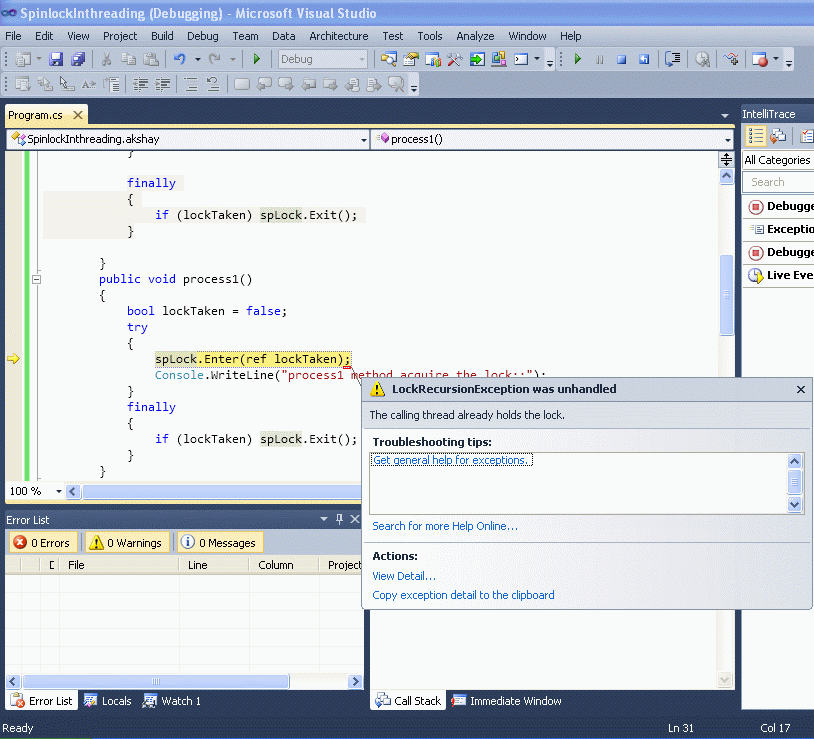
Fun with file locking - Mike Volodarsky's Blog. If you are developing code that uses distributed synchronization or messaging, you sometimes might need to use files as a locking mechanism. This can be useful because files are persistent (beyond thread, process, or even power session lifetime), and access to them is synchronized between multiple processes if you select the proper file access and sharing modes. C# example of taking a file lock: using (File. Stream lock. File = new. 
To install MarkedUp File Lock for C#, run the following command in the Package Manager Console. Release Notes. First public NuGet release Added documentation. ReaderWriterLock Class in C# Threading. When multiple reader threads acquire the same lock (remember ReaderWriterLock class allows. //Release Lock }. Other processes can read those bytes and read from or write to other parts of the file. Lock will throw. [C#] fs.Lock(pos, length. and release the lock only. Lock Statement (C# Reference). The lock keyword ensures that one thread does not enter a critical section of code while another thread is in the critical section. How to lock or unlock a file using C#? Visual Studio Languages.NET Framework >. I am using the following code to create a lock file. fstreamLock =. File. Stream( lock. Path, File. Mode. Open. Or. Create, File. Access. Read. Write, File. Share. Delete )){ // 1. Read lock information from file // 2. If not locked, write the lock information}If multiple threads or processes are accessing this lock file, the first process to open the file will lock it, blocking others from accessing it (more on why File. README.md file-lock. A simple file-locking implementation in C#. How File Locks Work. Taken from 'Easy Mode: Synchronizing Multiple Processes with File Locks' on the.  
Share. Delete and not File. Share. None in a moment). This provides the synchronization necessary for safe concurrent access of the file lock. Clients using the code should try to open the file in a try/catch loop, until a certain timeout is reached, to provide the blocking behavior for the file lock. Where it gets a bit more interesting is when you are done with the lock, and want to release it. A good way to do this is to delete the file (you could also write the file to indicate that you no longer hold the lock, but who wants to have left over lock files?). Naturally, you’ll want to first open the file with the same exclusive access as you did when locking it, to insure that you are still the one that holds the lock. Unfortunately, it turns out that there isn’t a way to delete the file using the file handle that you have already opened. You have to use the File. Delete(string path) API which calls WIN3. Delete. File() and re- opens the file in order to delete it, or re- open the file with File. Options. Delete. On. Close (FILE_FLAG_DELETE_ON_CLOSE). This is where you get into trouble because you already have the file open under a lock to prevent other writers from taking it. This is where our File. Share. Delete (FILE_SHARE_DELETE) comes in. By opening the file with this flag, we are prohibiting any lock taking operations from being performed, but allowing the file to be deleted by someone else. C# example of releasing the file lock: using (File. Stream lock. File = new. File. Stream( lock. Path, File. Mode. Open. Or. Create, File. Access. Read. Write, File. Share. Delete )){ // 1. Read lock information from file // 2. If locked by us, delete the file: File. Delete(lock. Path); }The file will be deleted as soon as our handle to the file is closed at the end of the using {} scope. Note that this example is meant as a mechanism for cooperative persistent file locking between multiple threads or processes. It is not meant as a way to guard against malicious or misbehaving code that wants to access the file, because anyone can break the rules while the file is not locked. The benefit of this approach is that you can create persistent file locks that do not necessarily go away when an owning process terminates, and do not require you to keep the file exclusively locked for the duration of the lock. You can also provide lock override or timeout semantics on top of this mechanism that would not be possible with an exclusive lock approach. You can also download theexample file lock library and source code (as is, no guarantees, no limitations on use). Using this library you can create file locks like this: using (File. Lock l = new. File. Lock(path, lock. Id, “mylock”)){ // do stuff under the file lock …} // lock automatically released here. Of course, there are other ways to do inter- process locking on Windows, including global mutexes, that may be more appropriate depending on the situation. If you work with the file system often, be sure to check out the Create. File documentation: http: //msdn. VS. 8. 5). aspx. Create. File is really the swiss army knife of Windows – having a good understanding of the access modes, sharing modes, and file flags can unlock a number of useful possibilities for your code. Best,Mike.
0 Comments
Leave a Reply. |
AuthorWrite something about yourself. No need to be fancy, just an overview. Archives
August 2016
Categories |
 RSS Feed
RSS Feed
